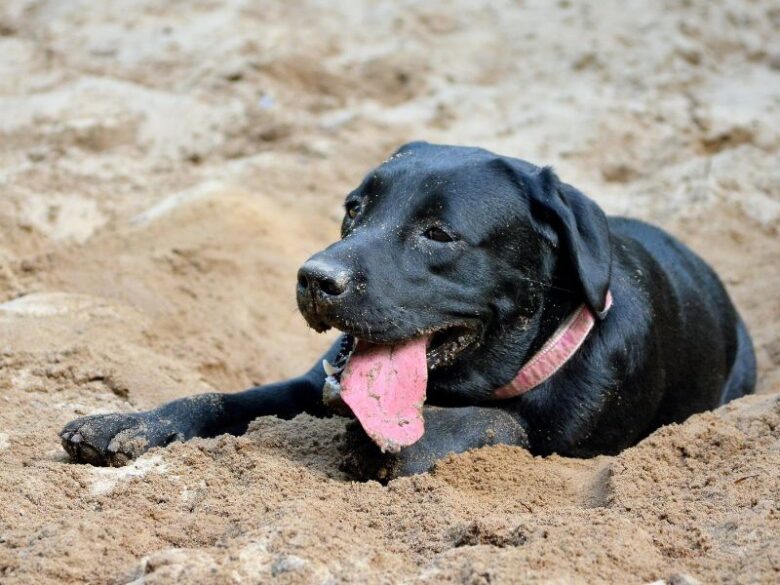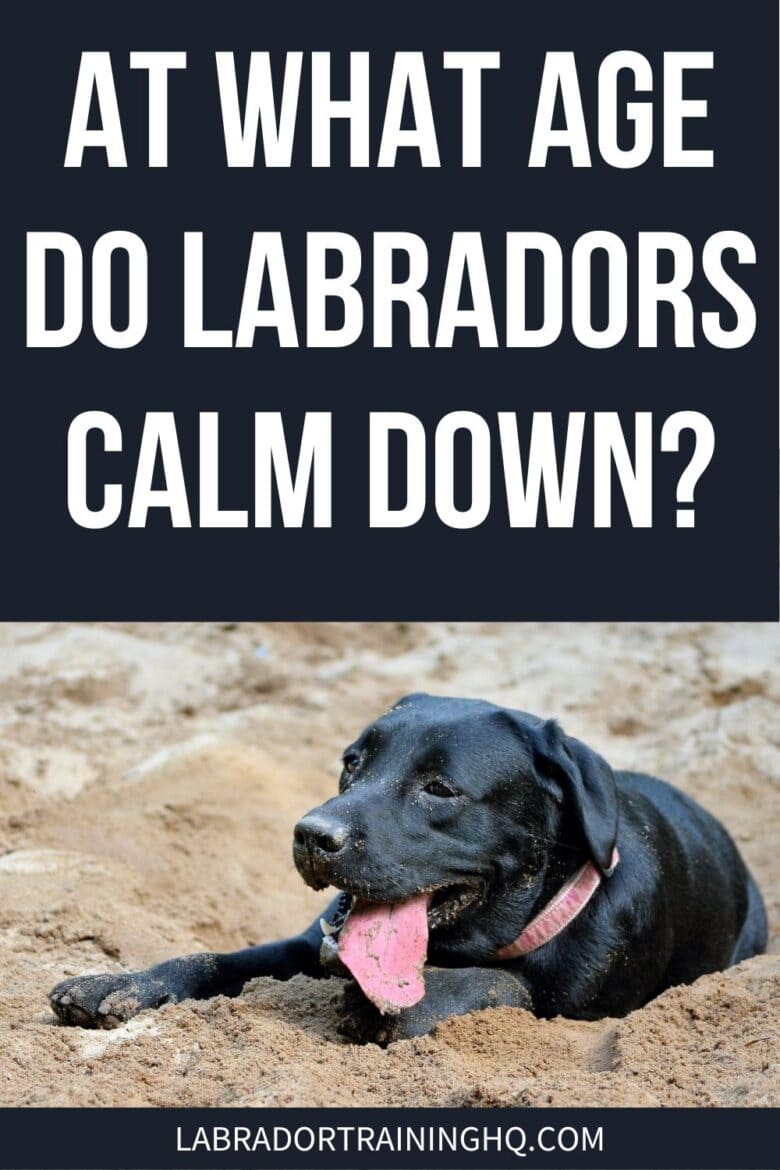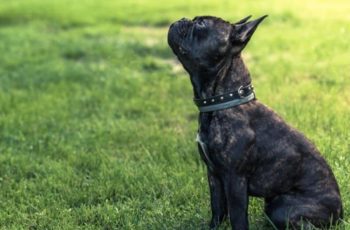This post may contain affiliate links. We may earn money or products from the companies mentioned in this post.
If you have a young Labrador retriever he’s probably trying to jump all over your guests to greet them and zoom around the room.
You’re probably wondering at what age do labradors calm down?
Young labs are the Energizer bunnies of canines. They have boundless energy and seem like puppies for a longer time than many other breeds.
But they do eventually calm down.
In this article, I’ll describe when you can expect your lab to calm down. And how you can deal with his energy throughout his youth.

Contents & Quick Navigation
Labrador Purpose and Types
Labrador retrievers are friendly dogs who love everyone–human and canine alike. No doubt that they make great family companions.
After all, they’ve been the most popular dog breed in the United States since 1991 according to the American Kennel Club.
They have boundless energy and were bred to work. They were originally bred to help with hunting and fishing and were tireless workers even in the icy waters of Newfoundland, Canada.
Labs currently are also used in hunting, to flush and retrieve game. So their origins and current abilities demonstrate that the breed is still energetic in line with its heritage.
There is one recognized labrador breed. Even though there is no official distinction, lab aficionados recognize two types of labs: the American lab and the English lab.
The American labrador is leaner and was bred to work whereas the English type has a stockier build and is bred for the conformation ring.
Because of their breeding, the American type generally is more energetic.
But don’t be fooled: all healthy labs are active dogs that need a job. If bored, they can become destructive.
At What Age Do Labradors Calm Down?
So you wonder when your tireless, bouncing lab will calm down. There are certain timelines when you can see a noticeable difference in your pup’s energy.
But I won’t fool you. Part of a lab’s charm is his puppy-like quality throughout his life.
Most dogs noticeably calm down between 18 and 24 months old. Generally, smaller dogs calm down at a younger age than larger breeds.
Labrador retrievers are a slow-maturing breed. But they will start to show more self-control in the home around two years old.
Speaking of slow-maturing, I often think the reason why guide and service dogs (mostly Labs) don’t start advanced training until they are around 18 months old is because that is around the age they finally start to calm down.
Although each dog’s an individual, labs really noticeably calm down between two to four years old, when they reach full mental and emotional maturity.
A healthy lab will still have bursts of energy then and even later in life and may do zoomies around your family room.
And most labs will still have a lot of energy, exuberance, and enthusiasm until four or five years old.
But your pup will have more innate impulse control than he previously had and he will noticeably have less excess energy.
Based on our experience, our first black Lab, Stetson began to calm down at around 2 years old. Our current black Lab, Elsa is almost 3 years old and still a ball of energy!
Stages of Development
As is true with any breed, a lab passes through various stages of development as he reaches maturity.
During the first six months, the lab is truly a puppy. He will become increasingly independent and ignore known commands. He’s also likely to test his limits and where he stands in the pack.
Between six and 18 months, your lab is an adolescent. He will be full of energy, boisterous, and exuberant and will keep learning new things and socializing with new people, animals, environments, and experiences.
By 12 months old, your lab will reach his full adult height. And he will add muscle and fat to his frame and will fill out between 18 and 24 months old.
Then he will appear as an adult, not a gangly adolescent. But appearances can be deceiving.
Although he may look like an adult, he still needs to develop emotionally and mentally.
Why You Should Calm Your Lab Down
A dog who is constantly overstimulated isn’t having a good time. Instead, he’s stressed. And constant anxiety isn’t good for any canine.
Also, a dog who can’t settle down is often bored and can be destructive. So he may engage in many unwanted behaviors such as excessive barking, chewing and destroying items, jumping on people, and pulling on clothes.
Of course you’ll want to avoid these behaviors or, if they already exist, work to eliminate them.
After all, they can be dangerous to your lab and others. If he inadvertently ingests something, a vet visit will be in order. And jumping around people can knock them down like bowling pins.
How To Calm Your Lab Down
The first few years with a high-energy dog like a lab are fun and exciting. But also challenging.
So while you’re waiting for your pup to chill out, there are methods you can use to help meet your dog’s needs and have a peaceful household. These practices will help your lab calm down.
After all, if your lab is too energetic and bored, he’s more likely to be destructive, chewing up household possessions and engaging in undesirable behaviors such as jumping or excessive barking.
1. Physical Exercise
Make sure that your lab has enough daily exercise. This can be a few long walks and some retrieving. Or even using a flirt pole can help.
Labs generally love water, so having them swim can be a great way to dispel excess energy. Most will be natural swimmers. But for those who aren’t, you can teach them to swim.
Most Labs love water, but in general the Labs we’ve raised and trained have not. Stetson really disliked water and many of the other guide dog pups refused to swim in the pool.
Two thoughts on this:
First, because guide dogs are not meant to swim and retrieve waterfowl maybe this trait has been bred out of the “guide dog” stock.
Second, we are taught not to allow our guide dog pups to go swimming anytime they feel like it. They are only allowed in the pool if we give them the okay. So, maybe the training the guide pups receive make it appear like they don’t like the water. Just a few thoughts.
You can even play a “round robin” game of calling your lab between various family members to help tire him out.
And doing other activities can help. These include hunting with your lab, field trials, tracking, dock diving, agility, obedience, rally, and flyball.
2. Mental Exercise
Mental stimulation is as important as physical exercise in releasing excess energy from your lab. It also helps expand his mind.
After all, labs are intelligent dogs who need a job and want to work alongside their people.
Have him explore puzzle toys. There are many, ranging from easy to more difficult.
I set up various puzzle toys for my dogs and, after exploring them, my pups are happily tired and ready for a nap.
3. Obedience Training
Training helps communicate with your lab and sets forth behavior rules that he should follow.
Manners training also helps with impulse control and calmer behavior.
Always mark the desired behavior with a reward marker such as saying “yes” and immediately give a yummy treat.
PRO-TRAINER TIP: Have a supply of great, yummy treats that your puppy can’t resist ready as a reward. They should be small, no larger than a pea. Always have your reward treats ready before giving your obedience cue. Using a special treat such as small pieces of cheese or boiled, deboned chicken can help a dog have a positive association with something.
At a minimum, you should teach your lab to do the following on cue: pay attention, come when called, walk on a loose leash, sit, lie down, leave it, stay, give and drop items, and be quiet.
And teaching tricks such as spin or wave can also help.
4. Socialization
Socializing your lab is important throughout his life.
Labs are naturally inquisitive, outgoing dogs and love to meet new people and friendly dogs.
So take your dog out to new places to have new experiences. This will help exercise your lab’s mind and body.
And he won’t be over-stimulated by new situations if he’s exposed to them properly on a regular basis.
5. Impulse Control Exercises
Teaching your lab to have self-control will help him learn to be calm, no matter what stage of development he’s at. This helps him have an “off switch.”
6. Teach him to “settle” on cue.
I teach this after a dog has had some physical exercise such as a walk or session playing fetch. You always want to set your dog up to succeed.
I sit in a chair with my pup on a six-foot lead and say “settle.” I’ll wait for him to comfortably lie down. He will if he’s had enough exercise.
Then I’ll calmly praise and reward him for settling down. And I’ll have something such as a stuffed frozen Kong ready to give him so that he will remain lying down calmly.
If you consistently teach him what “settle” means, he should eventually do so on your cue.
I often use my rescued Aussie mix Millie as an example of why impulse control exercises are so important.
She has boundless energy, as she should, but would be very difficult to live with if I didn’t work with impulse control exercises.
7. Teach a place command.
Teaching your dog to go to a place, such as a bed, and to lie down and stay there can help him calm down.
First decide where the bed will be located.
Then, lure your lab onto it by tossing a few treats onto it while saying the cue “bed.” Praise when all four legs are on the bed.
Gradually increase your criteria for when he will get rewarded.
After he will readily go stand onto the bed without the lure, praise and reward him for remaining there for longer periods of time.
When he knows the commands sit, down, and stay, you can have him perform those behaviors on the bed.
8. Teach sit, down, stay, and leave it.
These obedience commands are essential for any impulse control program.
After your lab knows these basic commands, you can start adding distractions so that he will be reliable in any setting.
And you can then use them in everyday life.
Have him sit before releasing him to eat his food and before exiting a door or crossing a street. And have him sit before other activities too such as putting on or removing his leash and harness.
Have him leave the rabbit that he wants to reach while on his walks.
9. Capture and reward calm behavior.
Behavior that’s rewarded will repeat itself. So have treats ready around the house out of reach from your dog.
If you see him perform calm behavior that you like, such as lying down or being quiet even when someone’s at the door, praise and reward that behavior.
The goal is to have him naturally perform desirable behaviors.
10. Teach an immediate “off switch.”
Rev up the pup, then have him immediately calm down. If your lab knows to tug on a toy then release it on cue, you can do this exercise a few times, so that he will learn to have an “off switch” even in stimulating circumstances.
So tell him “take it” as you hold the other end of the rope, then tell him “give” to release it—after you’ve trained these behaviors. You can play this same game with a flirt pole.
11. Teach a polite greeting.
Teaching a dog to greet people calmly is a great way to enforce impulse control.
And labs are so naturally friendly, they may be too boisterous when naturally greeting people.
Make sure that your pup’s had some exercise before the training session.
First do the training sessions with people your dog knows. Then, after he understands what’s expected, you can have him greet new people as part of the training.
This exercise is great for labs, as they are usually so friendly and want to greet everyone face-to-face.
You can start out with your dog safely tethered on a six-foot lead to a solid object while wearing a harness.
You approach. If your dog begins to jump, turn around and walk away.
After a few times, your pup should offer to sit. Then calmly mark the behavior (say “yes”) and give a treat reward.
Notice that you are not giving the “sit” cue. Instead, you want your dog to think what behavior we want and to repeat it.
You can also do a separate training exercise where you are holding the leash as someone approaches and you tell your dog to sit.
Make sure that your pup’s had a sufficient amount of exercise before this training session.
If your lab goes to jump, the person should turn and walk away. As the person approaches, cue your dog to sit. Calmly praise and reward when he sits.
12. Manage Your Dog’s Environment
If your pup’s over-stimulated by noises or sights outside the house, close the window and block the view. Play a TV or white noise machine.
Don’t leave him in a yard alone where he can practice unwanted behaviors such as barking. Instead, be present to redirect him to a desirable behavior.
If your lab’s overstimulated by things on his walks, such as people, vehicles, or animals, work on the issue at a distance he can handle.
Don’t engage in rough-housing. Reward calm behavior.
Part of managing your pup’s environment involves ensuring that other people don’t reward undesirable behaviors.
So don’t allow people to give your pup attention while he’s jumping. You’re the trainer of both your pup and the people around him.
13. Use Calming Techniques
It’s important that you remain calm around your pup.
If you seem too excited, your lab will feed off that energy. And his excitedness will probably be off the charts.
So try to keep a calm voice around him.
If you wave your arms around or use a high-pitched tone, your lab will probably become so boisterous that it would be very hard for him to calm down.
There are many holistic aids that can help a dog to calm down.
There’s music called Through a Dog’s Ear that’s been developed for this purpose.
A ThunderShirt correctly used can help alleviate stress and anxiety.
There’s a product called Adaptil that comes in a plug-in, spray, and collar which can help a dog calm down. The ingredients mimic the canine mother’s pheromones.
And there are calming tabs and Rescue Remedy that can be ingested to help a dog be serene. Always check with your vet first before giving anything to your dog that he needs to consume.
You can even teach a “relax” cue by calmly massaging your pup and praising and rewarding him for calm behavior. There are specific techniques described in the Tellington Touch that can help your pup relax.
14. Veterinary Assistance
If you’ve tried the above methods and your pup won’t calm down, a vet visit is in order. There may be a medical reason why your lab can’t settle down.
15. Behavioral Assistance
If you’ve done all that you can and your lab won’t appropriately calm down, you should seek the help of a positive reinforcement trainer or behaviorist with experience in calming dogs down.
What NOT To Do: Don’t Try This at Home
Don’t expect too much too soon. Even though you should see your lab become calmer over time, it will take two to four years for him to noticeably calm down.
Don’t use harsh methods to try to control his behavior, such as pinning him down. Instead, meet his exercise and training needs.
FAQs
My lab’s a year old and won’t settle down for any length of time! He still acts like a puppy. Is this normal?
Yes. Labs are a slow-maturing breed and, even though they may begin to appear as adults, they still are really puppies at heart.
Your lab will become mentally mature between two and four years of age and will noticeably calm down then.
In the meantime, make sure that you provide enough physical and mental exercise to meet his needs. And enjoy his puppy-ness! It won’t last forever.
Why is my six-month-old lab so out of control? Will he calm down?
A six-month-old lab is still truly a puppy and won’t have much impulse control. So make sure that he has enough physical and mental exercise and train him.
Do impulse control exercises with him. Eventually, over the next few years, he should become calmer.
A lab rescue has a four-year old lab for adoption. Is this too old? Will he still be playful?
A four-year-old lab can be a perfect companion. By that age, the puppy silliness and over-activity should be gone and he should be calm when needed.
But don’t mistake that for a lack of playfulness. A healthy lab is playful and fun into old age.
Final Thoughts
Young labs are full of vim and vigor. They are constantly in motion and sometimes a blur of activity.
Like any dog, they will naturally calm down over time. Between the ages of two and four, your lab should noticeably calm down. But still expect–and enjoy–his natural bursts of puppy-like energy.
Do you have a lab?
At what age did he calm down?
Please tell us about it in the comments section below.
Save To Pinterest

Top Picks For Our Dogs
- BEST PUPPY TOY
We Like: Calmeroos Puppy Toy w/ Heartbeat and Heat Packs – Perfect for new puppies. Helps ease anxiety in their new home. - BEST DOG CHEW
We Like: Bones & Chews Bully Sticks – All of our puppies love to bite, nip, and chew. We love using Bully Sticks to help divert these unwanted behaviors. - BEST DOG TREATS
We Like: Crazy Dog Train Me Treats – One of our favorite treats for training our service dog puppies. - BEST FRESH DOG FOOD
We Like: The Farmer’s Dog – A couple months ago we started feeding Raven fresh dog food and she loves it! Get 50% off your first order of The Farmer’s Dog.
For a list of all the supplies we get for our new service dog puppies check out our New Puppy Checklist on the PuppyInTraining.com blog.
At What Age Do Labradors Calm Down? was last modified: March 11th, 2023 by


